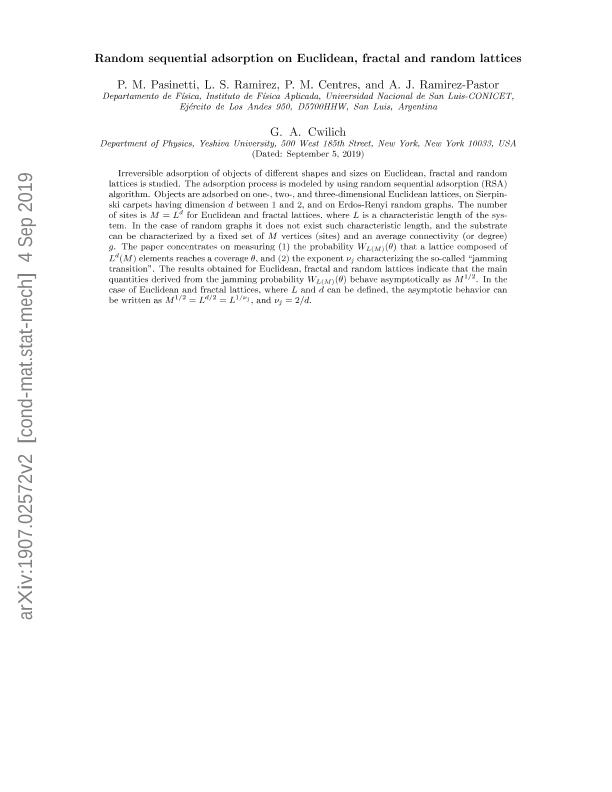Artículo
Random sequential adsorption on Euclidean, fractal, and random lattices
Pasinetti, Pedro Marcelo ; Ramírez, Lucía Soledad
; Ramírez, Lucía Soledad ; Centres, Paulo Marcelo
; Centres, Paulo Marcelo ; Ramirez Pastor, Antonio Jose
; Ramirez Pastor, Antonio Jose ; Cwilich, Gabriel
; Cwilich, Gabriel
 ; Ramírez, Lucía Soledad
; Ramírez, Lucía Soledad ; Centres, Paulo Marcelo
; Centres, Paulo Marcelo ; Ramirez Pastor, Antonio Jose
; Ramirez Pastor, Antonio Jose ; Cwilich, Gabriel
; Cwilich, Gabriel
Fecha de publicación:
11/2019
Editorial:
American Physical Society
Revista:
Physical Review E
ISSN:
2470-0053
Idioma:
Inglés
Tipo de recurso:
Artículo publicado
Clasificación temática:
Resumen
Irreversible adsorption of objects of different shapes and sizes on Euclidean, fractal, and random lattices is studied. The adsorption process is modeled by using random sequential adsorption algorithm. Objects are adsorbed on one-, two-, and three-dimensional Euclidean lattices, on Sierpinski carpets having dimension d between 1 and 2, and on Erdos-Rényi random graphs. The number of sites is M=Ld for Euclidean and fractal lattices, where L is a characteristic length of the system. In the case of random graphs, such a characteristic length does not exist, and the substrate can be characterized by a fixed set of M vertices (sites) and an average connectivity (or degree) g. This paper concentrates on measuring (i) the probability WL(M)(θ) that a lattice composed of Ld(M) elements reaches a coverage θ and (ii) the exponent νj characterizing the so-called jamming transition. The results obtained for Euclidean, fractal, and random lattices indicate that the quantities derived from the jamming probability WL(M)(θ), such as (dWL/dθ)max and the inverse of the standard deviation ΔL, behave asymptotically as M1/2. In the case of Euclidean and fractal lattices, where L and d can be defined, the asymptotic behavior can be written as M1/2=Ld/2=L1/νj, with νj=2/d.
Palabras clave:
RANDOM SECUENTIAL ASDORPTION
,
JAMMING
,
NETWORKS
Archivos asociados
Licencia
Identificadores
Colecciones
Articulos(INFAP)
Articulos de INST. DE FISICA APLICADA "DR. JORGE ANDRES ZGRABLICH"
Articulos de INST. DE FISICA APLICADA "DR. JORGE ANDRES ZGRABLICH"
Citación
Pasinetti, Pedro Marcelo; Ramírez, Lucía Soledad; Centres, Paulo Marcelo; Ramirez Pastor, Antonio Jose; Cwilich, Gabriel; Random sequential adsorption on Euclidean, fractal, and random lattices; American Physical Society; Physical Review E; 100; 5; 11-2019; 1-8
Compartir
Altmétricas



